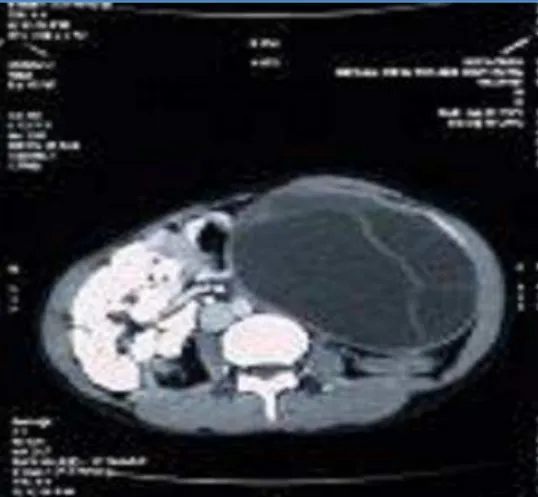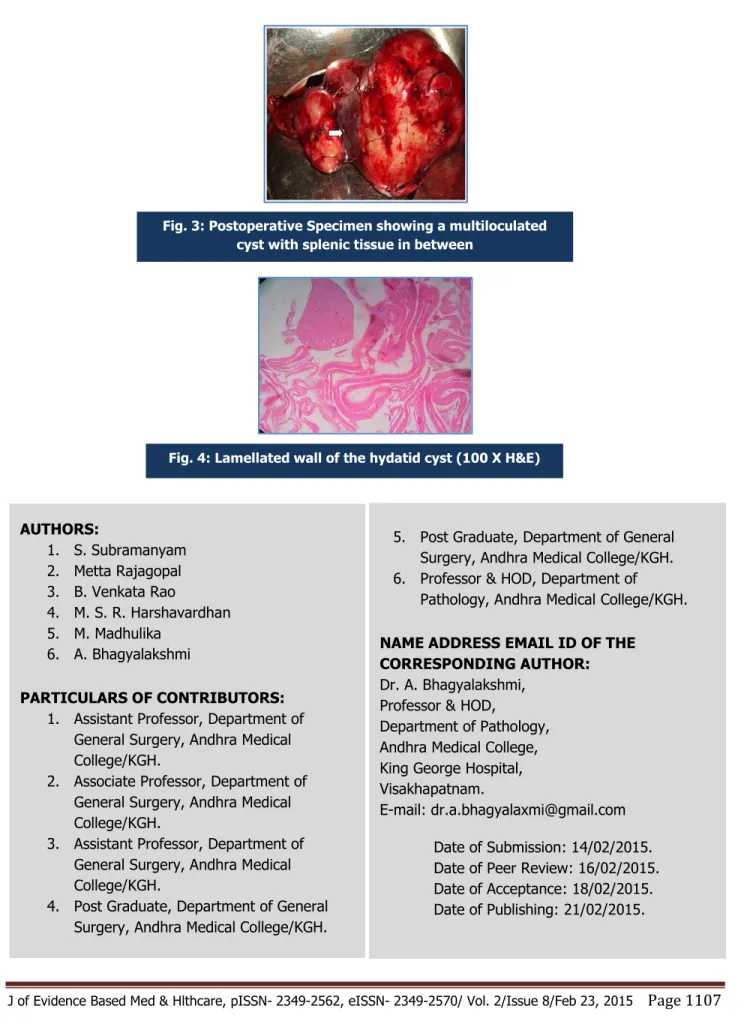CASE REPORT
J of Evidence Based Med & Hlthcare, pISSN- 2349-2562, eISSN- 2349-2570/ Vol. 2/Issue 8/Feb 23, 2015 Page 1103
PRIMARY GIANT HYDATID DISEASE OF THE SPLEEN: A RARE
CASE REPORT WITH REVIEW OF LITERATURE
S. Subramanyam1, Metta Rajagopal2, B. Venkata Rao3, M. S. R. Harshavardhan4, M. Madhulika5, A. Bhagyalakshmi6
HOW TO CITE THIS ARTICLE:
S. Subramanyam, Metta Rajagopal, B. Venkata Rao, M. S. R. Harshavardhan, M. Madhulika, A. Bhagyalakshmi. ”Primary Giant Hydatid Disease of The Spleen: A Rare Case Report with Review of Literature”. Journal of Evidence based Medicine and Healthcare; Volume 2, Issue 8, February 23, 2015; Page: 1103-1107.
ABSTRACT: The most common organ involved in hydatid disease is the liver, followed by the lungs. Hydatid disease of spleen is a rare clinical condition, as even in the endemic region the frequency is reported to be 0.5–4% of abdominal hydatid diseases. Most commonly splenic involvement is secondary i.e., along with other organs. Primary hydatid diseases in spleen is rare, here we are reporting a rare case of primary splenic hydatid disease.
KEYWORDS: spleen, hydatid disease, Echinococcus, splenectomy.
INTRODUCTION: Hydatid disease is a worldwide zoonosis produced by the larval stage of the Echinococcus tapeworm. Hydatid disease of spleen is a rare clinical condition, as even in the endemic region the frequency is reported to be 0.5-4% of abdominal hydatid diseases.[1]
CASE HISTORY: A 39 years female patient farmer by occupation presented with a mass in the left upper quadrant of the abdomen since 6 months and associated with dull aching pain in the left hypochondrium. Her present and past medical history was unremarkable. Her vitals were normal and on physical examination there was a lump occupying left hypochondriac, epigastric and umbilical regions with smooth surface. Mild tenderness was noted over the lump and there was no hepatomegaly. Her pulmonary, cardiovascular, central nervous, and the musculoskeletal systems were normal on examination.
CASE REPORT
J of Evidence Based Med & Hlthcare, pISSN- 2349-2562, eISSN- 2349-2570/ Vol. 2/Issue 8/Feb 23, 2015 Page 1104 given prophylactic vaccination against Streptococcus pneumoniae, Haemophilus influenza type B and Neisseria meningitides.
DISCUSSION: Hydatid disease is a worldwide zoonosis produced by the larval stage of the Echinococcus tapeworm. The two main types of hydatid disease are caused by E granulosus and E multilocularis. The former is commonly seen in thegreat grazing regions of the world and is the most frequently encountered type of hydatid disease in humans.[2] The life cycle of E granulosus involves two hosts. The definitive host is usually a dog, intermediate host sheep, sometimes human being.
The cyst is characterised by three layers, an outer pericyst derived from compressed host organ tissues, an intermediate hyaline ectocyst which is non-infective and an inner endocyst that is the germinal membrane and contains viable parasites which can separate forming daughter cysts.[2,3,4] Cyst fluid is clear or pale yellow, has a neutral pH, and contains sodium chloride, proteins, glucose, ions, lipids, and polysaccharides. The fluid is antigenic and may also contain scolices and hooklets. When vesicles rupture within the cyst, scolices pass into the cyst fluid and form a white sediment known as hydatid sand.[2,3]
The primary infestation of spleen usually takes place by the arterial route after the parasite has passed the two filters (hepatic and pulmonary). A retrograde venous route, which bypasses the lung and liver, is also reported. Secondary splenic hydatid disease usually follows systemic disseminated or intraperitoneal spread following ruptured hepatic hydatid cyst.[5]
Splenic hydatid cysts are usually asymptomatic but may present as a painful mass in the left upper quadrant. An enlarged spleen may be found. The complications of untreated splenic hydatid cyst are mainly infection, intraabdominal rupture and fistulization to the bowel, mainly colon. Rupture of splenic hydatid cyst into the thorax leading to splenothoracic fistula has also been reported. Severe anaphylactic reactions due to rupture of the cyst are also reported leading to fever, pruritus, dyspnea, stridor and edema of the face. Portal hypertension is also described with splenic hydatidosis.[6,7]
Main differential diagnoses of splenic hydatidosis are splenic cystic lesions such as pseudocyst, abscess, haematoma and cystic neoplasm.[8,9,10]
Eosinophilia may be the finding on hematological investigation. Hydatid immune electrophoresis, enzyme linked immunoabsorbent assay (ELISA), latex agglutination and indirect haemagglutination test are the different serological tests for diagnosis, screening and follow-up for recurrence.
RADIOLOGICAL FINDINGS: Marginal or crumpled eggshell-like calcifications in the splenic area on abdominal radiograph are suggestive of splenic hydatidosis. USG is the most sensitive modality for the detection of membranes, septa, and hydatid sand within the cyst. The cyst wall usually manifests as double echogenic lines separated by a hypoechogenic layer.[11]
In 2003, the WHO Informal Working Group on Echinococcosis (WHO-IWGE) proposed a
standardised ultrasound classification based on the status of activity of the cyst. Group 1: Active
CASE REPORT
J of Evidence Based Med & Hlthcare, pISSN- 2349-2562, eISSN- 2349-2570/ Vol. 2/Issue 8/Feb 23, 2015 Page 1105 contain viable protoscolices Group 3: Inactive group – degenerated, partially or totally calcified cysts; unlikely to contain viable protoscolices.[4]
In CT scan cystfluid usually demonstrates water attenuation (3–30 HU), Calcification of the cyst wall or internal septa is easily detected. Ahydatid cyst typically demonstrates a high-attenuation wall at unenhanced CT even without calcification.[11]
The standard treatment is splenectomy (Hoffman, 1957) as complete resection removes all parasitic and pericystic tissues. During surgical treatment extreme caution must be taken to avoid rupture of the cyst. Total splenectomy, partial splenectomy, cyst enucleation and unroofing with omentoplasty are the various preferred surgical techniques to treat splenic hydatid disease. Many trials are usually made for conserving the spleen, so as to avoid overwhelming post splenectomy sepsis (OPSI).[12] Laparoscopic approach has also been advocated for uncomplicated hydatid cyst of the spleen. Chemotherapy and newer methods, such as puncture, aspiration, injection, and re-aspiration (PAIR) technique using hypertonic saline or 0.5% silver nitrate solutions before opening the cavities tends to kill the daughter cysts. Medical treatment with albendazole has been shown to be effective in inoperable cases, in patients who refuse surgery, as an adjuvant therapy preoperatively, perioperatively, or post operatively if spillage occurs to minimize recurrence.
CONCLUSION: In conclusion, the infrequency with which it is encountered makes splenic hydatid disease a formidable early diagnostic challenge especially in nonendemic areas. Hydatid disease should be considered in the differential diagnosis of all cystic masses in the spleen especially in the geographical regions where the disease is endemic. Although the management must be individualized for each patient, a surgical resection is the best curative procedure. Postsurgical pharmacological treatment is necessary to ensure complete healing.
REFERENCES:
1. Teke Z., Yagci A.B., Atalay A.O., Kabay B. Splenic hydatid cyst perforating into the colon manifesting as massive lower gastrointestinal bleeding: an unusual presentation of disseminated abdominal echinococcosis. Singapore Medical Journal. 2008; 49: 113–116. 2. King CH. Cestodes (tapeworms). In: Mandell GL, Bennett JE, Dolin R. Principles and practice
of infectious diseases. 4th ed. New York, NY: Churchill Livingstone, 1995; 2544-2553. 3. Lewall DB. Hydatid disease: biology, pathology, imaging and classification. Clin Radiol 1998; 4. K Datta, Pawanindra Lal and Sanjay De Bakshi, Surgery in tropics. InBailey & love short
practice of surgery, Norman S Williams (ed) 26th edition, Edward Arnold publishers, London, 2013; page no75.
5. Kiresi DA, Karabacakoglu A, Odev K, Karakoese S. Uncommon Locations of Hydatid Cysts. Acta Radiol 2003; 44: 622.
6. Elfortia M, et al. Segmental portal hypertension due to a splenic echino cyst. Eur J Ultrasound 2000; 11: 21-3.
CASE REPORT
J of Evidence Based Med & Hlthcare, pISSN- 2349-2562, eISSN- 2349-2570/ Vol. 2/Issue 8/Feb 23, 2015 Page 1106 8. Safioleas M, Misiakos E, Manti C: Surgical treatment for splenic hydatidosis. World J Surg
1997; 21: 374-8.
9. Rahmani Sh, Mohammadi Tofigh A. Spleen-Preserving Surgery Versus Splenectomy for Splenic Hydatid Cyst: Ten Years-Experience. Shiraz E-Medical Journal Vol. 9, No.2, April 2008.
10.Karabicak I, Yurtseven I, Yuruker SS et-al. Splenic hydatid cyst. Can J Surg. 2009; 52 (5): E209-10. Free text at pubmed - Pubmed cystic neoplasms of the spleen 4.
11.Moguillanski SJ, Gimenez CR, Villavicencio RL.Radiología de la hidatidosis abdominal. In:Stoopen ME, Kimura K, Ros PR, eds. Radiología e imagen diagnóstica y terapeútica: abdomen. Vol 2. Philadelphia, Pa: Lippincott Williams & Wilkins, 1999; 47–72.
12.Amatzidis K., Papaziogas B., Mirelis C., Pavlidis T., Papaziogas T. Splenectomy versus spleen-preserving surgery for splenic echinococcosis. Digestive Surgery. 2003; 20: 527–531.
Fig. 1: CT scan demonstrating a multiloculated cyst in the spleen.
CASE REPORT
J of Evidence Based Med & Hlthcare, pISSN- 2349-2562, eISSN- 2349-2570/ Vol. 2/Issue 8/Feb 23, 2015 Page 1107
AUTHORS:
1. S. Subramanyam 2. Metta Rajagopal 3. B. Venkata Rao
4. M. S. R. Harshavardhan 5. M. Madhulika
6. A. Bhagyalakshmi
PARTICULARS OF CONTRIBUTORS:
1. Assistant Professor, Department of General Surgery, Andhra Medical College/KGH.
2. Associate Professor, Department of General Surgery, Andhra Medical College/KGH.
3. Assistant Professor, Department of General Surgery, Andhra Medical College/KGH.
4. Post Graduate, Department of General Surgery, Andhra Medical College/KGH.
5. Post Graduate, Department of General Surgery, Andhra Medical College/KGH. 6. Professor & HOD, Department of
Pathology, Andhra Medical College/KGH.
NAME ADDRESS EMAIL ID OF THE CORRESPONDING AUTHOR:
Dr. A. Bhagyalakshmi, Professor & HOD,
Department of Pathology, Andhra Medical College, King George Hospital, Visakhapatnam.
E-mail: dr.a.bhagyalaxmi@gmail.com
Date of Submission: 14/02/2015. Date of Peer Review: 16/02/2015. Date of Acceptance: 18/02/2015. Date of Publishing: 21/02/2015.
Fig. 3: Postoperative Specimen showing a multiloculated cyst with splenic tissue in between

